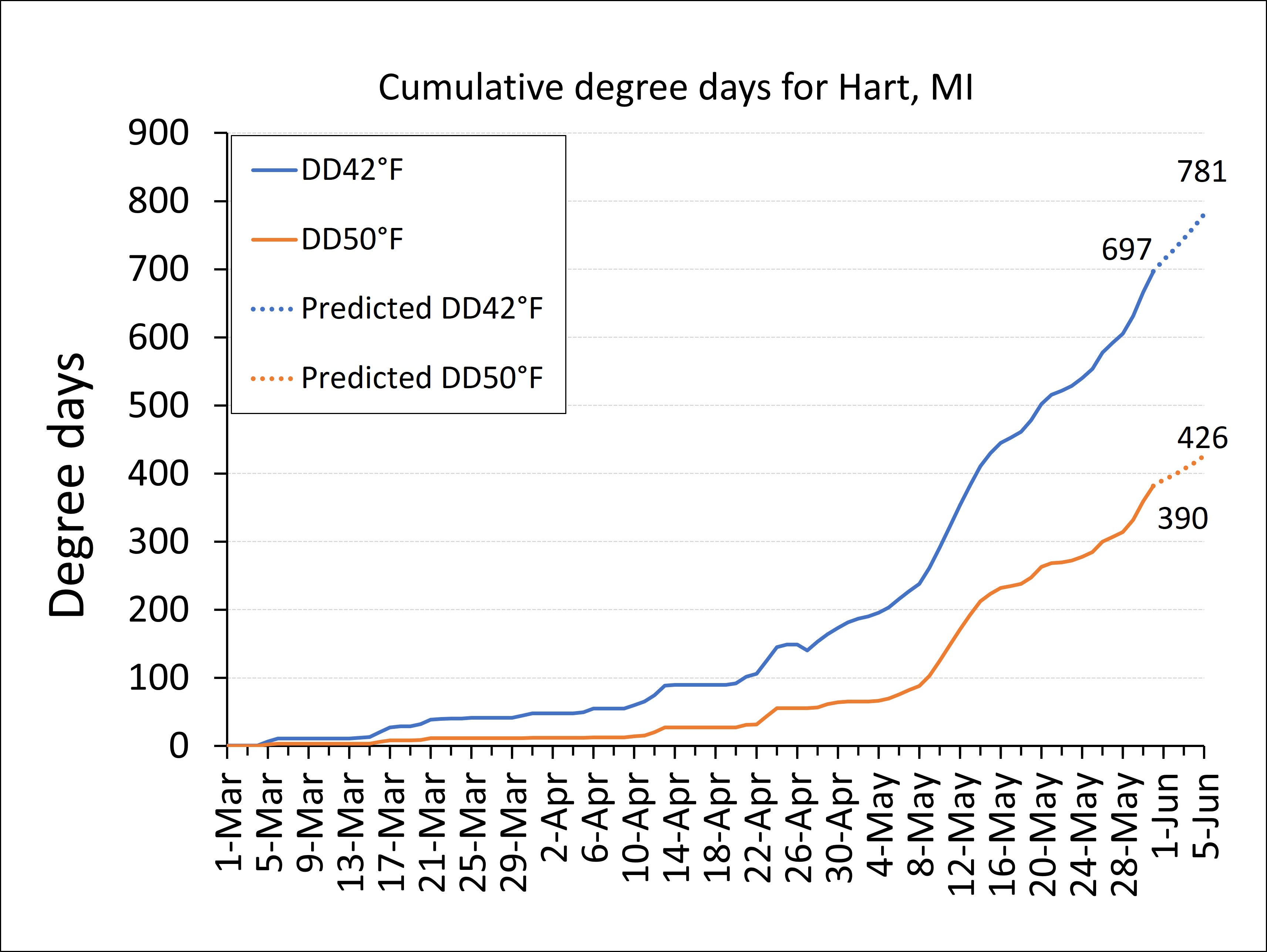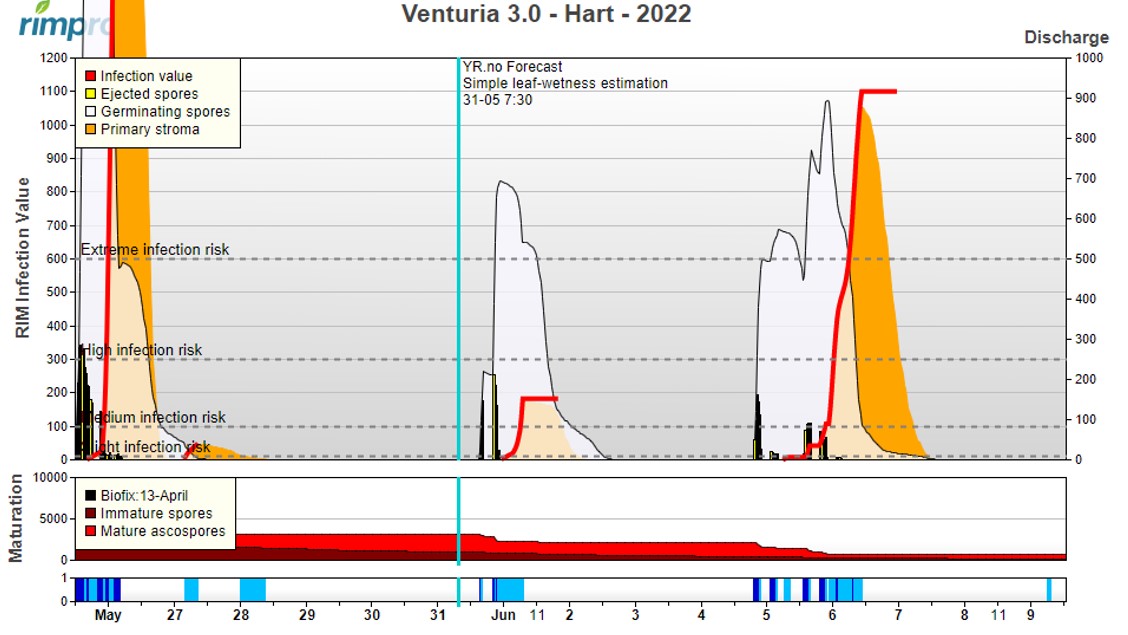West central Michigan tree fruit update – May 31, 2022
Cool temperatures have slowed fruit growth and insect activity this week.

Weather update
Warm weather over the weekend and early this week has led to steady fruitlet growth (Figure 1). Apple growers in the region took advantage of the warmer weekend temperatures to apply chemical thinners when fruitlets of most varieties were 6 - 10 mm in size.
Based on the Hart weather station for May 30, current DD accumulation is 703 DD42 and 390 DD50 (Figure 2). Accumulation of DD has increased by 180 DD42 and 119 DD50 over the past week. Across the region, DD accumulation is ahead of the 5-yr average (Table 1).

High temperatures on May 30 and 31 will be followed by cooler temperatures the rest of the week with highs in the mid to upper 70s. Conditions were windy on May 30 and 31 with wind speeds up to 15 mph in some areas.
Table 1. Current and 5-year average DD summary from Jan 1- May 30. Numerical integration was used for degree day calculations.
|
Station |
2022 DD Base 42°F |
5-yr Avg DD Base 42°F |
2022 DD Base 50°F |
5-yr Avg DD Base 50°F |
|
Benona/Shelby |
649 |
554 |
348 |
267 |
|
Elbridge/Hart |
702 |
639 |
396 |
328 |
|
Fremont |
748 |
697 |
422 |
365 |
|
Grant* |
757 |
695 |
424 |
367 |
|
Hart |
703 |
625 |
390 |
317 |
|
Ludington |
686 |
597 |
384 |
298 |
|
Mears** |
713 |
636 |
397 |
318 |
|
New Era** |
704 |
608 |
388 |
291 |
*Averages were calculated using data from 2020-2021.
**Averages were calculated using data from 2018-2021.
Last week, rain events occurred on May 25 and 26 across the region (Table 2). Today, May 31, a storm system is moving to our region from the central plains, and rain showers and thunderstorms are forecasted for tonight and tomorrow. This storm is predicted to bring high winds from the south/southwest and potential hail in our region according to Dr. Jeff Andresen, Michigan State University. High winds and sunny weather in the region are leading to high evapotranspiration rates and rapid depletion of soil moisture. Some locations may remain dry even if there is rainfall. Irrigation may be needed this week particularly for new plantings or young orchards. To watch Dr. Andresen’s current weather report, click here.
Table 2. Rainfall totals from rain events on May 25-26 at Enviroweather stations in West Central, MI.
|
Station |
Rainfall (in) |
|
Benona/Shelby |
1.16 |
|
Elbridge / Hart |
0.58 |
|
Fremont |
0.49 |
|
Grant |
0.48 |
|
Hart |
0.88 |
|
Ludington |
0.93 |
|
Mears |
1.08 |
|
New Era |
0.63 |
Weather data was gathered from Enviroweather https://enviroweather.msu.edu/
More information and reports on normal weather conditions and departures from normal can be found on the NOAA Climate Prediction Center website, NOAA U.S. Climate Normals website, NOAA Climate Normals Quick Access Page (which may be searched by region) and Midwest Regional Climate Center website.
Crop update
Warm temperatures the past few days have led to consistent fruitlet growth, but cool weather later this week may slow development. Many growers have put on first cover sprays to target active pests and to continue management of apple scab and cherry leaf spot. Apple growers also took advantage of warmer temperatures over the weekend to apply chemical thinners. Effects of thinning applications can be evaluated later this week. For growers interested in monitoring fruitlet growth to determine if additional thinning applications are needed, growers can use the fruitlet growth model. Here is a link to an MSU Extension video and article that explains the Fruit Growth Rate Model that is available on the Malusim app.
Apple varieties in the West Central region are at fruit set, and fruitlet diameter is being monitored. In Hart, fruitlet diameters of many varieties, such as Gala and Honeycrisp, range from 8-12 mm. Jonagold fruitlet diameters range from 12-15 mm. Growers are advised to consider if another thinner application will be needed. For Hart, MI, the NEWA Cornell Apple Carbohydrate Thinning Model is predicting a carbon surplus for May 31 and June 1, and the model recommends a 30% increase in chemical thinning rate. Cooler temperatures later this week may limit efficacy of thinners.
For more thinning recommendations, growers can access the 2022 Thinning Guide.
For specific information on thinning strategies for Honeycrisp in 2022, check out this article from MSU Extension specialist, Anna Wallis, Honeycrisp Crop Management for 2022.
Tart and sweet cherry fruits range from 7-12 mm in diameter.
Peaches are at shuck split or fruit set. In some locations, fruitlet diameter is about 7-10 mm.
Pear fruit diameters have an average of 11 mm.
Pest and disease update
In the West Central region, growers should continue scouting blocks to target hot spots for active pests in the orchard according to growth stage. Warmer temperatures this weekend led to more pest activity. Damage for plum curculio was observed on tart cherries. Growers should remain vigilant to protect against cherry leaf spot, apple scab, and powdery mildew given the rain and warmer temperatures this week. If rag tag bloom remains on apple trees, growers should consider continuing to manage fire blight.
Early season pests
Black stem borer adults are active in warmer temperatures. Trapping near woodlots or injured trees is recommended to monitor for flight of females.
Codling moth biofix was estimated for May 14. Sustained trap catch has occurred, and the start of first generation egg laying was predicted for May 26.
European red mite were observed this week. Warm and dry conditions are favorable for larvae activity so cool conditions are likely slowing down mite development. The recommended treatment threshold for European red mites is 5-7 mites per leaf through July.
Obliquebanded Leafroller is predicted to have sustained catch in late May due to the cooler weather this week. Sustained catch is expected at 900 DD42. Scout orchard blocks in the coming weeks to determine if a spray is needed. Consider Bt sprays in problem blocks.
Oriental fruit moth biofix 1 is estimated to have occurred on May 9. Sustained trap catch has occurred.
Pear psylla adults and newly laid eggs were found in the region. Early management is key to keeping damage thresholds low through the season.
Plum curculio damage was observed on cherries this week. Growers should continue to monitor their orchards for damage, especially in areas that border wood lots.
Redbanded Leafroller adult flight is low in the region. Continue to monitor this minor tree fruit pest.
Rosy apple aphid is a common pest in our region. Growers can scout for colonies of dark purple nymphs in fruit clusters and treat blocks as needed.
San Jose scale is present in some orchards in the region. Targeted sprays or oils can be used for infested trees to manage scale and target adults. Growers should monitor in blocks where scale were present on fruit in 2021. San Jose scale may feed on apple, pear, plum, apricot, and sweet cherry.
Spotted tentiform leafminer activity may be higher this week because of warmer temperatures. Adults have been trapped in low numbers in the region. Larvae that feed on sap of leaves may be present shortly.
Disease update
Apple scab: RIMPro forecast is predicting a medium infection risk for apple scab infection on June 1 and an extreme infection risk on June 6 (Figure 3). Wettings events are predicted on June 1 and June 5-6. Spores continue to mature, and we expect another spore release with upcoming wetting events this week.

Powdery mildew: Warm temperatures and high humidity this week may result in powdery mildew infection. Powdery mildew causes infections on the underside of the leaf that lead to chlorotic patches or spots on the upper side of the leaf. Growers should continue to spray for powdery mildew through midsummer.
Cherry leaf spot: Wetting events this week may lead to infection periods for the cherry leaf spot fungus, Blumeriella jaapii. Disease pressure was high in 2021 in West Central, and maintaining coverage of new tissue will be critical this season. Cherry leaf spot should be managed in both bearing and non-bearing orchards.
Fire blight: Some apple varieties may still have open blossoms across the region. It is important for growers to keep blossoms protected from fire blight if they open. If bloom is over, growers should focus on minimizing shoot blight and the development of cankers that overwinter. Growers are encouraged to scout for symptoms of shoot blight and continue management with an Apogee and Actigard program.
For pest and disease management recommendations, please refer to the E-154 for product guidelines.
For more information about regional reports, please visit the Michigan State University Extension webpage.



 Print
Print Email
Email

